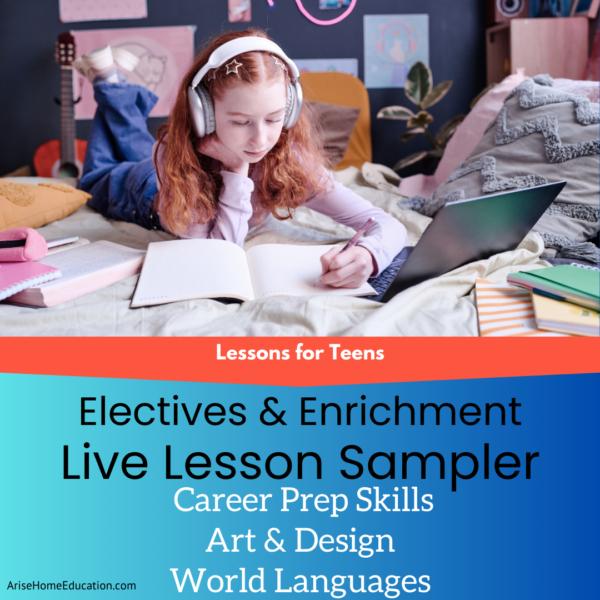Understanding the Basics of Online High School Art Curriculum
Overview of Online Art Curriculum Options
Christian home educators are limited in their options for online high school art curriculum that supports their conservative Christian world-view whilst helping their children gain the technical skills they desire. Most programs offer flexibility while ensuring a comprehensive study of the visual arts, and online classes can provide a structured environment, guiding students through a progressive exploration of artistic concepts. Homeschool students benefit from the varied resources available, like video tutorials, interactive sessions, and digital art projects. But finding all these qualities from a Christian perspective infused in everyday learning for teens is difficult. At Arise Home Education, we provide a high school art curriculum in a unique environment and in a way that supports both the UK Arts Award and US high school qualifications without sacrificing Christian values.
In general, online art curricula cater to different interests and skill levels. They should include elements of art and principles of design as foundational components. Students should have the opportunity to learn through a blend of practical exercises and theoretical knowledge from a Christian worldview perspective. At Arise Home Education, our approach ensures a well-rounded education in the visual arts with the extra bonus of learning how to use and develop artistically to ‘honour and glorify God in all we do’ (1 Corinthians 10:31).
Online Art Classes For Teens
-
High School Art and Design Year 1
Original price was: £340.00.£320.00Current price is: £320.00. -
High School Art and Design Year 2
Original price was: £340.00.£320.00Current price is: £320.00.
Integrating Essential Elements and Values
A good high school art curriculum should cover the elements of art, principles of design, and color theory. These are crucial for developing a student’s artistic skills and critical thinking. Understanding these elements enables high school students to analyze and create art effectively. Teaching these concepts in a structured manner can lead to a deeper appreciation of art.
Integrating art history and art appreciation into the curriculum enriches the learning experience. It provides context and inspiration, helping students connect with the broader world of art. For Christian homeschoolers, selecting a curriculum that aligns with faith values is essential. This can be achieved by choosing programs that incorporate Christian perspectives into art history and analysis. Ensuring the curriculum fits educational goals and personal values can enhance the learning journey for high school students.
Structuring Art Projects for Middle and High School Students
Engaging Art Projects for High School Students
Creating engaging art projects is key to sparking interest in high school students. Art curriculum in high school should include diverse subjects. At Arise, we have found that projects that allow for personal expression resonate well with students. These could involve color theory, where learners explore the emotions that colors evoke. Encourage them to create pieces that reflect their unique perspectives. Art history and principles of design can also serve as inspiration for students to create contemporary works. This approach not only bolsters their art appreciation but also deepens their understanding of cultural influences.
High school art curriculum should also challenge students with critical thinking. Arise art tutors, introduce students to abstract art and modern techniques through hands-on experience in Art and Design Year 1 and Year 2. These projects help students develop analytical skills as they interpret and create. For example, students analyze different abstract works, then apply the elements of art to produce their own versions. Emphasizing hands-on projects fosters a deeper engagement with art, enabling students to connect theory with practice. These types of projects help them earn art credit or portfolio projects toward the UK Arts Award while developing a well-rounded understanding of visual arts.
Differentiating Projects for Homeschool Students
Homeschool students benefit from projects tailored to their skill levels. Middle school students may need basic projects focusing on the elements of art and principles of design. Simple, structured guidance helps them grasp foundational concepts. For example, start with primary color mixing projects or basic composition exercises. As they advance to high school, challenge them with more complex art projects that demand creativity and independence. With the guidance offered in Art & Design 1 & 2, your teens will enjoy exploring new ideas and stretching their creativity as they engage with a variety of art projects throughout each course.
Online class resources can provide diverse project ideas and instructions. Different skill levels require varying degrees of complexity in projects. In some cases, our tutors will consider offering tiered assignments where students complete projects based on their level of ability. This differentiation ensures that all students, regardless of skill, get a comprehensive education in visual arts. A thoughtfully crafted art curriculum allows students to progress well, ensuring enjoyable engagement in their art education journey.
Incorporating Art History and Appreciation into the Curriculum
Contextualizing Visual Arts Through Art History
Teaching art history within the homeschool setting offers context for understanding the visual arts. It’s vital for high school students to grasp the evolution of art movements and styles. Art history provides a backdrop to the principles of design and elements of art. This context helps students appreciate how art has shaped and been shaped by culture and society. Understanding these connections deepens their appreciation and fosters critical thinking skills. When students learn about periods of art, they gain insight into the artists’ motivations and influences.
For Christian homeschoolers, resources should be tailored to explore the relationship between faith and art. Art history celebrates various expressions of spirituality. Exploring works like the Sistine Chapel or classical religious paintings can provide a rich perspective. These works offer insight into how faith influenced artists and their creations. Engaging with these pieces allows homeschool students to reflect on the importance of their faith in their own creative journeys.
Boosting Creativity and Analytical Skills
Art appreciation is a key component in boosting creativity and analytical skills. By engaging with diverse visual arts, students enhance their ability to analyze and critique. Understanding color theory through art projects helps them see the connection between colors and emotions. These exercises foster creative thinking and encourage students to explore their artistic voices. Encouraging exploration of different art movements helps students recognize the significance of art in history and its relevance today.
Arise online classes offer a wealth of art and design learning opportunities tailored to homeschoolers. These can include virtual museum tours, documentaries, and live lessons. Projects can focus on replicating styles from different art movements. These activities help students understand the principles of design in practice. By examining works of art, students can discuss their interpretations during the fortnightly live session. This process not only enriches their knowledge but also helps them earn art credit/qualifications towards their high school education. These skills are invaluable in developing well-rounded, analytically minded individuals.
Building a Supportive Online Learning Environment
Creating a Positive Virtual Atmosphere
Creating a positive virtual atmosphere is vital for any online high school art course. For homeschool students, it starts with selecting the right online class. Look for classes that emphasize visual arts, art appreciation, and critical thinking. Teachers should focus on the elements of art, color theory, and the principles of design. This ensures a well-rounded experience. Encourage high school students to explore various styles of art and art history. This fosters an open-minded approach to art projects.
Engagement is key in an online setting. At Arise, we use technology tools to enhance art projects. Our interactive platforms can make art appreciation come alive by providing discussion forums, students can inspire collaboration among fellow classmates, and encouraging students to share their thoughts on the art topics being studied. These activities enrich their learning experiences in a Christ-centred environment.
Navigating Art Credits and Assessments in Homeschooling
Documenting and Assessing Art Projects for High School Credit
Homeschool students pursuing art credits need a structured approach. If you are building your own high school art curriculum, remember it should align with academic standards. This ensures credit legitimacy. Begin by documenting each art project. Include detailed descriptions and objectives. Track time spent on each project. This demonstrates dedication and learning progression. Art projects should reflect elements of art and principles of design. Showcase skills in color theory and abstract art. This documentation aids in evaluating growth and understanding.
Creating a portfolio is essential. Compile student artwork to showcase creativity and development. A well-rounded portfolio highlights various media. Include paintings, drawings, and digital art. It should show students’ ability to apply art history and art appreciation. An organized portfolio can impress college admissions. It shows critical thinking through the visual arts. It is also a tangible record of high school students’ artistic journey.
At Arise, we partner with home educators to provide the structured approach to art necessary to achieve UK Art Awards and US high school qualifications/credits.
Online Art Classes For Teens
-
High School Art and Design Year 1
Original price was: £340.00.£320.00Current price is: £320.00. -
High School Art and Design Year 2
Original price was: £340.00.£320.00Current price is: £320.00.
Are Arise Live Classes A Good Fit For Your Teen?
Grab a live lesson bundle and learn about the course, the tutor, and the weekly homework load.
You May Also Enjoy
Art & Science Activities For Kids
- Navigating Online High School Art Curriculum: Essential Tips for Christian Homeschoolers
- Basic Cooking Class Fun for Teens
- Math Readiness: High School Advanced Maths for Teens
- Speech and Drama Class for Home Education Families
- High School Photography Curriculum | Online Homeschool
FAQ
Online high school art curricula provide flexibility while ensuring a comprehensive study of visual arts. They offer structured environments that guide students through artistic concepts and provide varied resources such as video tutorials, interactive sessions, and digital projects.
A solid high school art curriculum should cover the elements of art, principles of design, and color theory, which are essential for developing artistic skills and critical thinking.
Integrating art history and art appreciation into the curriculum enriches students’ understanding of art and connects them with the broader world of artistic expressions, allowing for a deeper appreciation of cultural influences.
Projects that allow for personal expression, such as color theory explorations and contemporary works inspired by art history, are effective. These projects encourage creativity and critical thinking.
Art projects should be tailored to individual skill levels, with simpler projects for younger students and more complex assignments for high school students. Tiered assignments allow students to complete projects based on their skill and ability.
Teaching art history provides context for understanding visual arts, helping students grasp the evolution of art movements and styles, which deepens their appreciation and fosters critical thinking skills.
Art appreciation enhances students’ ability to analyze and critique art, fostering creative thinking and encouraging exploration of their artistic voices through understanding different art movements.
Document each art project with detailed descriptions, objectives, and time spent on tasks. Create a portfolio that showcases creativity and development in various media, reflecting the student’s understanding of art principles. Consider partnering with Arise Home Education Art & Design Year 1 and Year 2 for online art classes.







1 thought on “Navigating Online High School Art Curriculum: Essential Tips for Christian Homeschoolers”
Comments are closed.